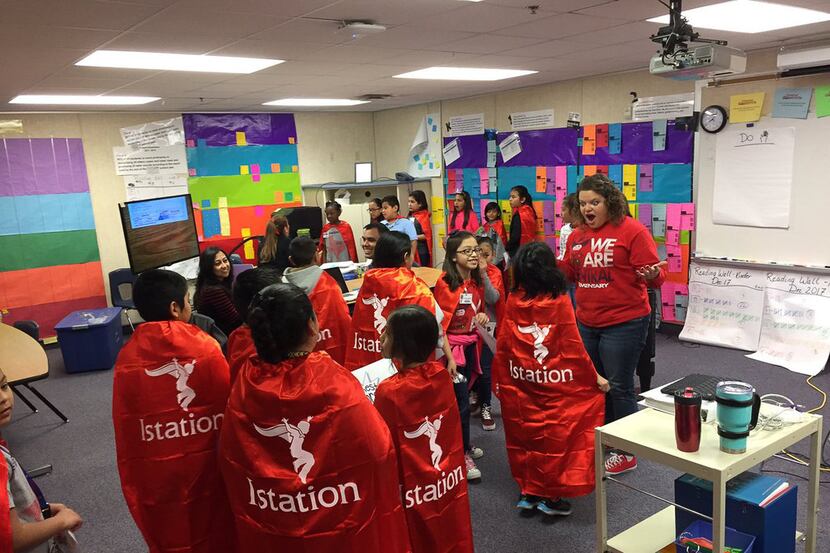If you travel along North Central Expressway and Northwest Highway, you’ve undoubtedly noticed the Istation sign atop one of Campbell Centre’s gold-glass office towers.
And unless you’re an elementary or middle-school educator, you’ve probably wondered what that stood for.
No, it’s not part of a media corporation.
Istation is a $100 million enterprise devoted to making education as captivating as playing video games.
If you're old enough, you might remember Schoolhouse Rock! — you know, "Lolly, Lolly, Lolly, Get Your Adverbs Here," "Conjunction Junction [What's Your Function]" and other songs that stuck like glue while mindlessly teaching you grammar, math, science, history and civics.
I know the words to the preamble to the U.S. Constitution by heart thanks to these Saturday morning TV cartoons. But I have to sing to remember them.
Istation is taking this education-as-entertainment concept to digital heights with animation, music, storytelling and video games while teaching reading, math and Spanish to kids in pre-K through the eighth grade.
On the other side of the equation, Istation programs enable teachers, principals and superintendents to track progress for every student, classroom or school under their purview.
In 20 minutes, they can tell which kids are at risk and which are ready for advancement ahead of the class.
Derek Little, Dallas ISD’s assistant superintendent for early learning, uses Istation three times each school year to assess the reading levels of kindergartners through second-graders.
“We approach Istation through the lens of, ‘How do we provide information to teachers that tells them where every student is in their learning trajectory in the classroom?’ and provide the teacher with direction on what should happen next with that student,” Little says.
Tia Maddox, a retired kindergarten teacher at Colleyville Elementary, was a beta tester for Istation’s data analytics and is sold on the program.
“They check for everything: comprehension, vocabulary, the smallest details,” Maddox says. “The same thing with math. ‘OK, this kid doesn’t know how to skip-count by twos.' I could group my kids according how their assessments were.”
Man in the red cape
Istation’s guiding force is 70-year-old Dallas multi-millionaire Dick Collins, who built his fortune in banking, real estate, wildcatting and media investments.
But education is the soul of his entrepreneurship.
Collins was among those who interviewed Stephanie Knight last year for the deanship of Southern Methodist University’s Annette Caldwell Simmons School of Education and Human Development.
“I knew from our conversation that if Simmons had the kind of support and wise counsel from its executive board that Dick represented, then SMU was the place I wanted to be,” Knight says.
“One of the issues Dick cares about in education is leadership,” says Knight. “He helped us establish the Institute for Leadership Impact to reach out with professional development to educators who may not have sufficient opportunities, such as superintendents in rural areas and independent school administrators.
“He has encouraged me to think big and has helped Simmons find resources to make our vision a reality.”
Collins, who was the deep pockets of the founding group in 1998, took over as CEO in 2007 after the company had slipped for several years — pulling in less than $3 million in annual revenue.
In 2012, Collins came up with the company’s logo — a boy leaping into the air wearing a red cape.
“Every child can be a superhero,” says Collins, who says he was an average student growing up. “Every child has some unique ability. They might not be the best student, but they could have some other skill. Our job is to help kids be able to read, learn their math, learn Spanish and transition to English.
“If we can do that, we can make a difference.”
Today the company is on a rapid incline, adding schools and districts around the world as well as expanding its curriculum with $100 million in revenue expected in 2018.
Istation operates in eight countries. It serves 1,700 U.S. school districts with a total of 4 million students at 8,500 schools nationwide. And it’s apparently making a lot of money.
“Everybody’s in favor of effective use of technology in schools,” says Collins, the grandson of Dallas’ legendary insurance magnate and philanthropist Carr P. Collins Sr. “So why wouldn’t you build a world-class educational network delivered online, making it fun, engaging and creative?
“The only way to really move numbers in the education industry is through technology. Our program works — and I can prove it. It’s easy to use. And it’s cheap. That’s our business model.”
A golden perch
Collins is the business mastermind. Bill Lowrey is the company’s technology strategist.
Lowrey was just 32 when the Richardson dot-com he worked for stopped meeting payroll.
“Maybe that wouldn’t have been the end of the world, but my second daughter was due to arrive in two weeks. My first one was 14 months old,” says the now 52-year-old co-founder and chief technology officer of Istation. “I had an existential crisis staring at the ceiling in the middle of the night and thinking, ‘OK, I need to do something with my life. What do I want to do?’
"I realized I’d really like to do something that makes the world slightly better than when I started in it.”
So he, a handful of engineers and a business partner persuaded Collins to back this idea of making classroom computers more than a station for video games.
Fast-forward two decades, and Istation has about nearly 200 former educators, digital programmers, graphic designers and artists, sales, marketing and technical support staff occupying three floors of one of the most visible office towers in town.
“As a guy who had five other people when we started, I’m pretty excited about that,” Lowrey says, sitting in his office that overlooks NorthPark. ”Name on the building? How cool is this?”
When less is more
Lowrey determines the direction and the strategy of Istation’s technology, and he's found North Texas’ higher-ed institutions to be a strong feeder system for Istation’s tech needs.
“We’ve got all these bright graduates from SMU, UTD, UNT and Richland College, who are bringing a more modern view to the way that our content is put together,” he says.
One of Istation’s advantages is that its network was designed to work in environments with less-than-adequate technology.
“Native American reservations have satellite connections to the internet. That’s not an environment that typical digital content works well in,” he says.
“Our animation uses a lower bandwidth. And we designed in the ability for schools to download a program to one computer and then make sure that all the other computers could access it without having to go across the internet connection.”
Visions of unicorns
Both Collins and Lowrey make it clear that Istation isn’t slowing down anytime soon.
“We’re going to be doing much more interesting things than just asking people multiple-choice questions in the future,” says Lowrey. “That’s exciting and going to be transformative for the industry.”
And financially, well, Collins has great expectations.
“We have an excellent shot of having a valuation of $300 million in three years, a good shot at $500 million and a long shot at becoming a unicorn,” Collins says, referring to a privately held company that somebody would have to pay at least $1 billion to buy.
That would be a big payday for him, since Istation is nearly debt-free and owned primarily by him.
Istation has worthy competitors in the digital education space, but Collins contends that his company has a more complete spectrum of online curriculum and assessment.
“The only thing that would keep us from reaching all of our goals is if we don’t sell as effectively as we have in the last five years,” Collins says. “We have a first-class sales team, and I’m the No. 1 salesman.”
What does he like most about being CEO of a digital education company?
“We get to help kids. That sounds flip enough, I understand that. We get to help people help the education system. This system is change-averse. There’s no sense of urgency. No punishment for failure. And it’s incredibly bureaucratic.
“We can help with all that stuff. We’re going to save lives and have fun doing it.”

AT A GLANCE: Istation
Headquarters: Dallas
Founded: 1998
Ownership: 76 percent owned by Dick Collins and affiliates; remainder held by management team, board and key employees.
Employees: 250 full-time
Scope of operations: Seven foreign countries, 1,700 U.S. school districts and 8,500 U.S. campuses with a combined 4 million students.
Richard H. “Dick” Collins
Title: Chairman and CEO, Istation
Age: 70
Resides: Preston Hollow
Education: Bachelor's degree in business administration, Southern Methodist University, 1969.\
Personal: Divorced with two grown daughters and three granddaughters
Bill Lowrey
Title: Chief technology officer, Istation
Age: 52
Resides: Far North Dallas
Education: Bachelor's of science in mathematics, University of Houston-Clear Lake City
Personal: Married to Michele Lowrey for 25 years,. They have two daughters, 19 and 20.

